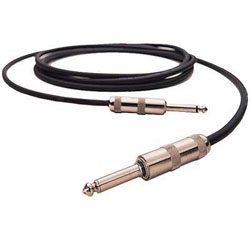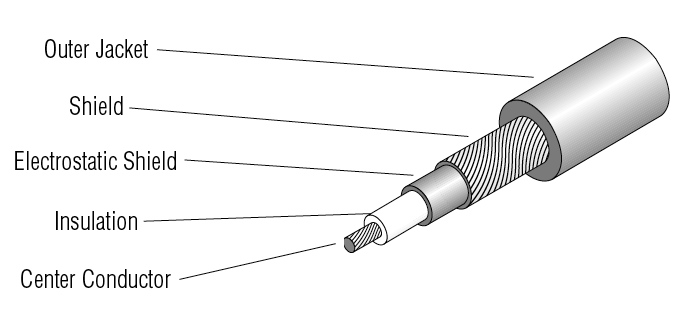Are instrument cables used for high-impedance or low-impedance lines?
Generally, the source impedance is the determining factor in cable selection. Instrument cables are used for a wide range of sources.
Many keyboard instruments, mixers, and signal processors have very low (50 to 600 ohm) source impedances. On the other hand, typical electric guitar or bass pickups are very inductive, very high impedance (20,000 ohms and above) sources.
Typical load impedances are greater than 10,000 ohms, which limits the electrical current flow to a very small amount on the order of a few thousandths of an ampere (milliamps).
How much power does an instrument cable have to carry?
The voltages encountered range from a few millivolts, in the case of the electric guitar, to levels over ten volts delivered by line-level sources such as mixers. By Ohm’s Law this represents power levels of less than a thousandth of a watt.
What kind of frequency response does an instrument cable need? What are the lowest and highest frequencies produced by the source?
The bandwidth spans the entire audible range of frequencies, from the 41 Hz (and below) of bass guitar and synthesizer to the 20 kHz harmonics of keyboards and cymbals.
Recording applications demand wide bandwidth to preserve the “sizzle” of a hot performance. Even an electric guitar has a bandwidth of about 82 Hz to above 5 kHz.
How big does an instrument cable need to be? Will a bigger cable sound better? Will a bigger cable last longer?
In order to be compatible with standard 1/4-inch phone plugs the diameter of the cable is effectively limited to a maximum diameter of about .265”.
Larger cable diameters demand larger plug barrels, which sometimes won’t fit jacks that are located close together or in tight places. In terms of both sound and durability, “it’s not how big you make it, but how you make it big.”
What are the basic parts of an instrument cable and what does each one do?
The coaxial configuration is generally used for unbalanced instrument cables.
At its simplest it consists of a center conductor, which carries current form the source, separated by insulation from a surrounding shield, which is also the current return conductor necessary to complete the circuit.
These three components are augmented by an electrostatic shield to reduce handling noise and an outer jacket for protection and appearance.
What is a stranded center conductor? Why is it important?
A stranded conductor is composed of a number of strands of copper wire bunched together to form a larger wire.
Solid conductors having only one strand are the cheapest and easiest to work with when assembling cables, because they do not require the twisting and tinning that stranded types need to prepare them for soldering.
The problem with a solid conductor is that it quickly fatigues and breaks when it is bent or flexed.
This makes stranded conductors a must for cables that are frequently moved around, especially when they are attached to human beings playing music.
Finely stranded conductors increase the cost of the cable because of the increased production time and the expensive and sophisticated machinery required to assemble very small and fragile strands into a single conductor.
The stranding of the center conductor is only one of a number of factors that influence the overall flexibility of a given cable, but it is generally true that finer stranding increases the flexibility and the flex life of the cable.
















